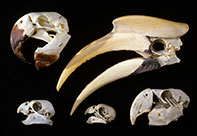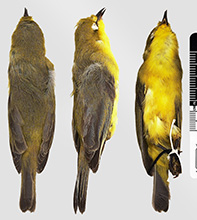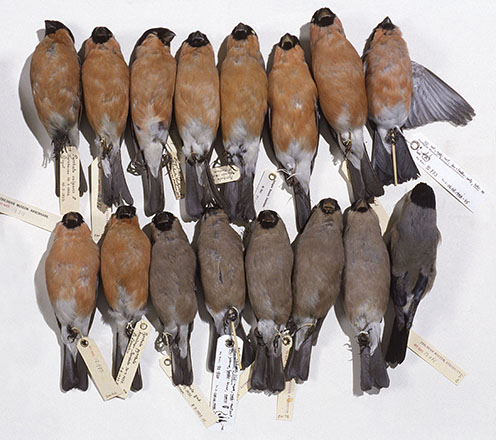Bird collection
Curator
Collection manager
About the collection
The ornithological collections comprise approximately 120,000 skins of 5,700 species of which half are from Denmark and the North Atlantic area.
The egg collection comprises c. 17,000 clutches, primarily collected in the Nordic countries but also includes some non-catalogued exotic clutches. The anatomical collection comprises c. 11,000 specimens in ethanol and 15,500 skeletons (for half of these the skin is also preserved). The tissue collection comprises c. 35,000 samples of 3,600 species, with broad geographical coverage. We have 6,000 mounted specimens collected worldwide, primarily from former exhibits.
Rarities include a skull and other type material of the Dodo (Raphus cucullatus) and sub-fossil material of Dodo and Rodrigues Solitaire (Pezophaps solitaria); two mounted specimens, an egg, soft tissue (in ethanol) and skeleton parts of Great Auk (Pinguinus impennis); a Crested Shelduck (Tadorna cristata) and 69 type specimens.
Nearly all specimens are identified to species, 85% are catalogued and the tissue collection is digitized. Extensive regional and global databases on birds as well as African vertebrates (1.5 million records) have been prepared as part of the curatorial work.
6,900 sound recordings from South America (Niels Krabbe) are available on CD-ROM and deposited at The British Library Sound Archive, London (”BLOWS”) and Macaulay Library, Cornell Laboratory of Ornithology (“LNS”).
Subsamples for genetic studies have already been provided from c. 50% of the tissue samples, resulting in c. 400 published titles so far (112 with coauthors from the museum). In order to improve the basis for studying trait evolution there is a strong focus on increasing the anatomical collections.
Taxonomic coverage
(2014): c. 70% of the world's species (35% for tissue).
Bird collections in numbers
- Estimated number of specimens/collections: c. 120,000 skins, 35,000 tissue samples, 6,000 mounted specimens, c. 17,000 clutches, c. 11,000 specimens in ethanol, 15,500 skeletons
- Types: 69 (all digitized)
Strengths
- 120,000 skins, c. 70% of the world’s species.
- 35,000 frozen tissue samples of 3,600 species (35% of the world’s species), with broad geographical coverage and active collection.
- Great Auk specimens, egg, soft tissue and skeleton parts. Dodo skull and sub-fossil Dodo and Rodrigues Solitaire material. Crested Shelduck specimen.
- 69 type specimens.
Important subcollections/specimens/collectors
- Most skins from Denmark are lighthouse kills from the late 19th century and stockbroker Lehn Schiøler’s private collection.
- Lehn Schiøler’s collection comprises more than 20,000 skins of ducks and geese, collected for detailed study of age and seasonal variation in plumage.
- More than 800 skins in the collections of Gyrfalcon Falco rusticolus, primarily from Greenland are from a time when a bounty was paid for killing raptors.
- Other well represented areas are West Siberia (Hans Johansen), Afghanistan (Knud Paludan), coastal China (Axel Hemmingsen), the Philippines and Melanesia (Galathea and Noona Dan expeditions; Lorenz Ferdinand, Finn Salomonsen, Torben Wolff, Jon Fjeldså) and Tanzania (Thorkild Andersen), Brazilian highlands (J. Th. Reinhardt). In addition, there is recent material from the Andes (Jon Fjeldså, Niels Krabbe), Tanzania (Jon Fjeldså), the Solomon Islands (Jon Fjeldså), Indonesia and Papua New Guinea (Knud Jønsson).
- Anatomical material includes substantial series of individuals of known age (primarily Cygnus olor, Accipiter gentilis, Buteo buteo and Larus argentatus) but also provides a broad taxonomic coverage, which is rapidly increasing.
- Of historical interest are approximately 100 mounts from the early 19th century (Peter C. Wöldike).

